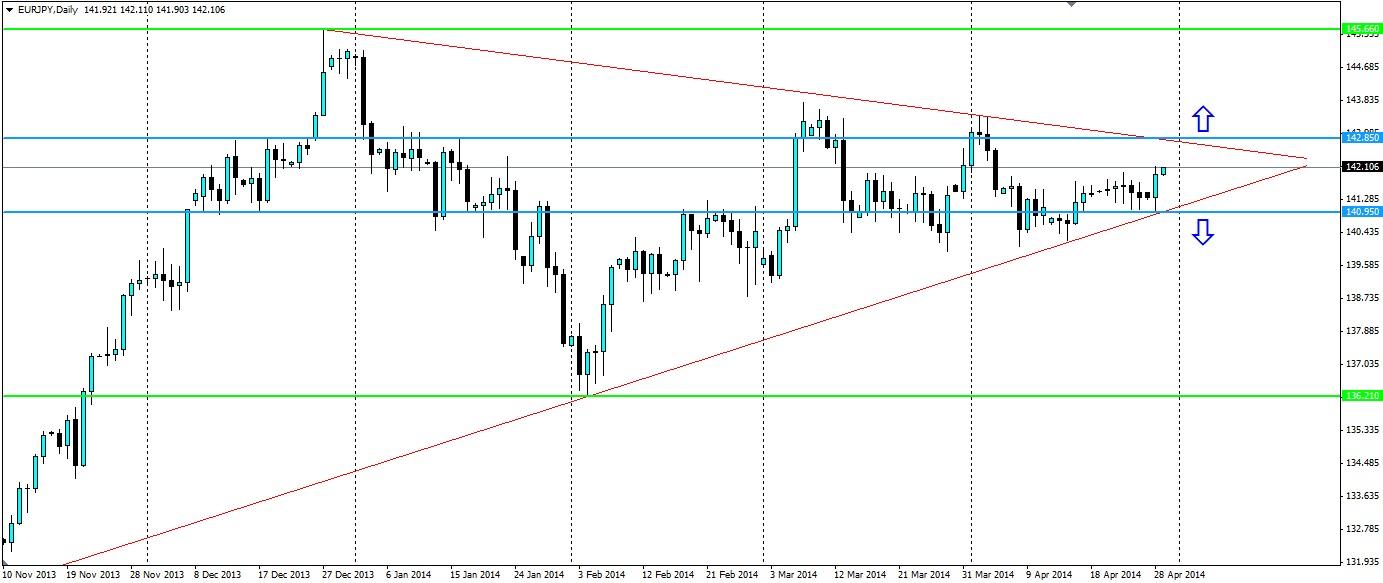As I have spoken about in a previous article, Japan and Europe are in a virtual staring contest.
Japan
Japan is attempting to pull itself out of decades of deflation through Abenomics. The BoJ has said it will expand the money supply and it is going to expand its asset purchase programme however it has not specified when this will occur. Many traders are expecting this by July and any hint from the BoJ will send the Yen tumbling. At this stage the BoJ is likely waiting on data to show overall health and for the recent sales tax increase to work its way through the economy.
Latest CPI figures show prices expanding 1.6% year on year, not quite at the targeted 2.0%, but certainly heading in the right direction for the BoJ. If things continue this way we may not see an increase to their QE programme.
Europe
On the other hand, Europe’s latest figure has seen a CPI increase at just 0.5% year on year. This is a significant slide from the 1.7% inflation rate seen this time last year. The President of the ECB Mario Draghi has reiterated his stance that they are prepared to help with any necessary measures, however, he also told German lawmakers yesterday that a Quantitative Easing programme isn’t imminent. There is even some in the market who believe this is all just a bluff and he has no plans to actually act. They point to the Eurozone crisis in 2012 that didn’t end up in a breakup of the zone. Back then he pledged “whatever it takes”, however, he didn’t end up having to do much.
If, however, Draghi does enact an asset buying programme, it may not have the desired impact. When Japan and the US enacted theirs, equity prices were extremely depressed and the news was a positive shock to the market. Having talked for quite some time about it, QE may not have as big an impact as Draghi is hoping. He may well be aware of this fact, so might try to double bluff the market with the timing or size of it, however, this is all just speculation at this stage.
Either way the market will be looking for any sign from the upcoming economic data to show the direction of both economies. If this cross rate starts to move, it could fundamentally shift.
Pennant
A potential exists here for a strategy to profit from either economy making a move on Quantitative Easing. An entry can be set to either buy just above the top of the shape at 142.85 or to sell just below at 140.95. That way once the price exits the constricting trend lines and continues in that direction, one of these entries will be triggered to follow it. Initial targets will be the resistance at the top of the chart at 145.66 and the support found when the price touched the bullish trend at 136.21. The all-important stop losses should be set just outside the shape on the opposite side, around where the entry for the other trade is, that way we minimise our losses if a false breakout occurs.
The beauty of this trade setup is that we can follow the price inwards. That is; the difference between our entry trades will get tighter the longer the price stays within the pennant as we will move our entries along the trend lines. If we maintain our targets, the risk/reward ratio for this setup will only improve.
Forex and CFDs are leveraged financial instruments. Trading on such leveraged products carries a high level of risk and may not be suitable for all investors. Please ensure that you read and fully understand the Risk Disclosure Policy before entering any transaction with Blackwell Global Investments Limited.
Recommended Content
Editors’ Picks
AUD/USD posts gain, yet dive below 0.6500 amid Aussie CPI, ahead of US GDP

The Aussie Dollar finished Wednesday’s session with decent gains of 0.15% against the US Dollar, yet it retreated from weekly highs of 0.6529, which it hit after a hotter-than-expected inflation report. As the Asian session begins, the AUD/USD trades around 0.6495.
USD/JPY finds its highest bids since 1990, approaches 156.00

USD/JPY broke into its highest chart territory since June of 1990 on Wednesday, peaking near 155.40 for the first time in 34 years as the Japanese Yen continues to tumble across the broad FX market.
Gold stays firm amid higher US yields as traders await US GDP data

Gold recovers from recent losses, buoyed by market interest despite a stronger US Dollar and higher US Treasury yields. De-escalation of Middle East tensions contributed to increased market stability, denting the appetite for Gold buying.
Ethereum suffers slight pullback, Hong Kong spot ETH ETFs to begin trading on April 30

Ethereum suffered a brief decline on Wednesday afternoon despite increased accumulation from whales. This follows Ethereum restaking protocol Renzo restaked ETH crashing from its 1:1 peg with ETH and increased activities surrounding spot Ethereum ETFs.
Dow Jones Industrial Average hesitates on Wednesday as markets wait for key US data

The DJIA stumbled on Wednesday, falling from recent highs near 38,550.00 as investors ease off of Tuesday’s risk appetite. The index recovered as US data continues to vex financial markets that remain overwhelmingly focused on rate cuts from the US Fed.
